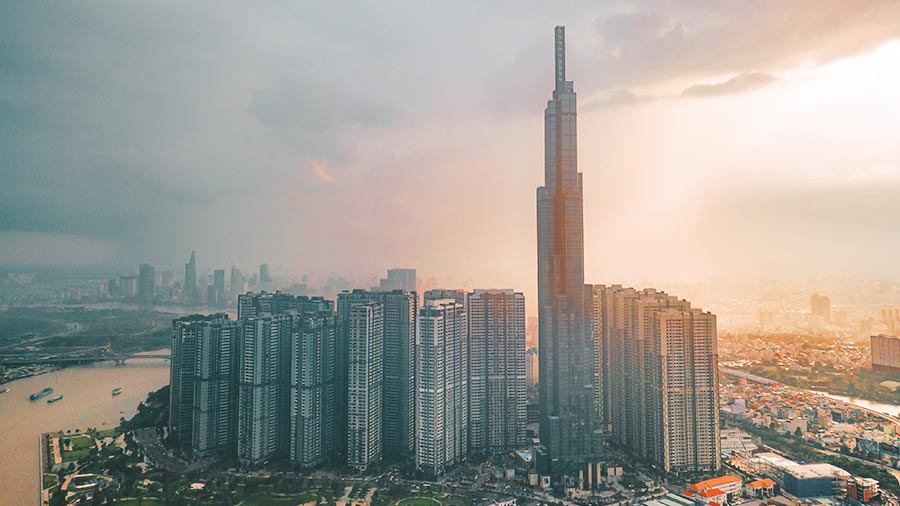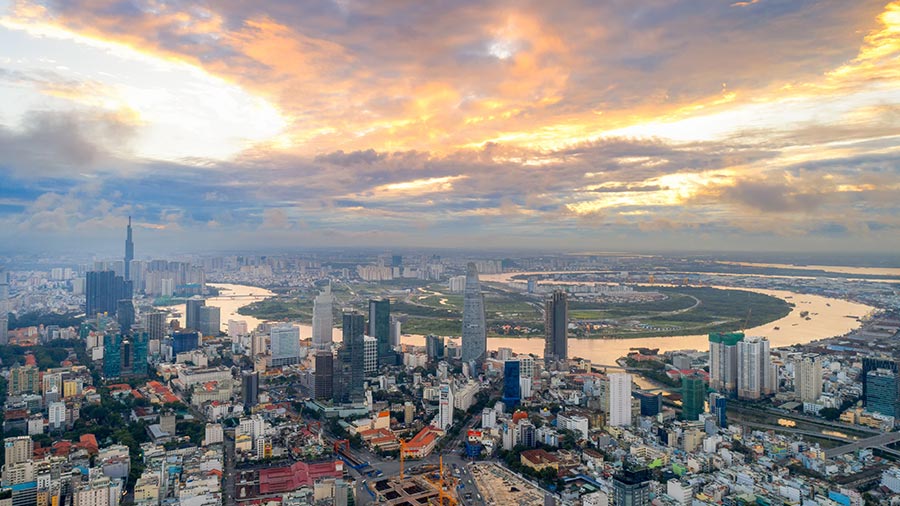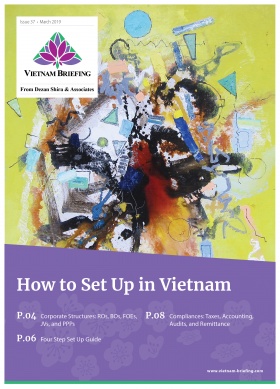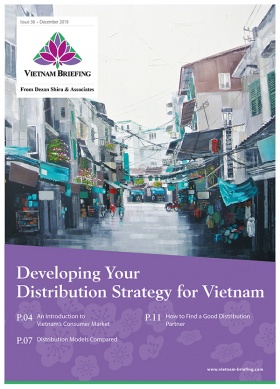A Guide to District 2, Ho Chi Minh City – Thu Thiem New Urban Area
District 2 in Ho Chi Minh City is one of the biggest urban development areas in Southeast Asia. The show case redevelopment project is the Thu Thiem New Urban Area, which is touted to become the new central business district of Ho Chi Minh City.
New cities are usually built far from the city centre. In the case of District 2 it’s opposite the historic old city, on the other side of the Saigon River.
Ho Chi Minh City has an opportunity that is unparalleled for a city this size. Thu Thiem is located on a peninsula of land where the Saigon River meanders into an almost full circle. It’s planned to be the new financial district of HCMC, taking the pressure off the buildings and roads of old Saigon.
Comparison with Pudong, Shanghai
Thu Thiem has drawn comparisons with Shanghai, where the new city of Pudong was built on the other side of the river of old Shanghai (The Bund). Like Saigon, Shanghai was once referred to as “the pearl of the east” or “pearl of the orient”.
And like Shanghai, Saigon is building a new city across from the old. This similarity has likened Thu Thiem as “the Pudong of Southeast Asia”.
Pudong (which means “the East Bank of the Huangpu River”) was mostly farmland until it became a Special Economic Zone in 1993. Thu Thiem was also under-developed land on the east bank of the river (and dong is also east in Vietnamese).
Similarities end there though. Thu Thiem is not an SEZ, and so far it has not been built with the singular focus that the Chinese government has put into turning Pudong in the the financial capital of China.
Development of Thu Thiem
There have been plans to develop Thu Thiem that go back decades. Originally, French colonialists had drawn up a map, and plans were made again in the 1960’s and 70’s.
Planning began again in the late 90’s, and land clearance began in 2002. An international design competition was held, and in 2003 the master plan by Sasaki Associates was selected.
Since then the project has become mired in delays. While District 2 was under-developed compared to District 1, it was not unoccupied. In fact, there were thousands of homes in Thu Thiem. Resettlement of land owners has been an issue, and important land title maps went missing.
Most of the prime land on the Saigon River waterfront has now been cleared, giving the impression that not much has happened.
If you are looking from the riverbank of District 1, you wouldn’t be blamed for thinking that nothing has happened yet. Go beyond the riverfront and you will see there are already many completed projects in District 2, with more big projects underway.
New city area of District 2
There are other names that are also used in relation to District 2 which you may sometimes encounter. Districts of Ho Chi Minh City are broken up into wards.
There are 11 wards in District 2, one of which is Thu Them. As you will see in this post, some developments in the Thu Thiem New Urban Area aren’t technically in Thu Thiem, but the name Thu Thiem New Urban Area is becoming interchangeable with new city area of District 2.
East Ho Chi Minh City generally refers to the districts east of the Saigon River (District 2, District 9, and Thu Duc). East Ho Chi Minh City is sometimes referred to in relation to the new smart and innovative city, though news reports about what this means is lacking in detail. Given how big this area encompasses, it’s not smart that there isn’t a bigger plan for public transport.
This article is a comprehensive guide to every major project in District 2. It includes apartment towers, mixed use developments, public transport and infrastructure, along with public buildings and architectural landmarks. Projects are listed by ward and in no particular order.
Thu Thiem – Empire City
Empire City is one of the signature projects of the Thu Thiem New Urban Area, being on prime riverfront land next to the Thu Thiem tunnel. The development is being built in stages by four developers.
The Empire 88 Tower is designed by Büro Ole Scheeren, and this 88-storey tower is currently the tallest building planned for District 2 (over 300 metres). This is by the same architect that designed the MahaNakhon Tower in Bangkok.
Lotte Eco Smart City
Lotte Eco Smart City is a mixed-use development on one of the two plots of riverfront land that faces Downtown District 1. This project has been delayed for years but it appears that an official design announcement will be made in 2019.
Lotte said that there will be “an iconic tower” in the plan, so with the Empire Tower next door it would make the waterfront look like a mini Pudong.
Thu Thiem Square and Riverside Park
The central point of the Thu Thiem New Urban Area will be Thu Thiem Square. This is opposite Me Linh Square in District 1, and will be connected by a pedestrian bridge.
The square (or trapezium if we are being geometrically correct) is wedged between Lotte Eco Smart City and the City Planning Exhibition Center.
Part of this development package also includes Riverside Park, which will be a pedestrian area between the two new bridges connecting Districts 1 and 4 to District 2. The square and riverside park will have the capacity of accommodating up 500,000 people for cultural events.
According to the developer’s website, the Central Square & Riverside Park is scheduled to be completed before April 30, 2020 to commemorate the 45th anniversary of Vietnam’s unification.
Thu Thiem Parish Church
There used to be a settlement on the Thu Thiem riverbank until the land clearance began in preparation for the new urban development. One of the few remaining buildings is the Thu Thiem Parish Church compound. The future of the church had been uncertain for over a decade, but it now appears that the church will remain. The church is in front of the Lotte development area.
Near the church used to be the ferry that connected District 1 to Thu Thiem, which was discontinued after the Thu Thiem tunnel opened in 2011.
Opera House / Performing Arts Centre
Next to the future Thu Thiem 2 Bridge is a proposed opera house or performing arts center. There is no official design yet, so various renders are online of what it might look like. Ho Chi Minh City authorities have approved over US$64.3 million for the project, due to begin construction in 2020.
Sala City
Sala City is a mixed-use development by Dai Quang Minh Corporation. It’s the biggest development in terms of land footprint, taking up the lower half of the Thu Thiem peninsula.
Approximately half of the area includes the Southern Delta ecological park. This wetland will be conserved and integrated into flood mitigation of the peninsula.
The rest of the project is divided into different sections of villas, shophouses, apartment towers, parks, and schools.
At the centre of the Thu Thiem New Urban Area is the Dai Quang Minh Corporation office tower. It’s on the prominent corner of Mai Chi Tho and Nguyen Co Thach, and from District 1 it’s a useful landmark as the geographical centre of the peninsula.
DQM Corp are building this development as part of a Build Transfer (BT) program. They are building the four main roads of Thu Thiem, the central square and riverside park, Thu Thiem 2 Bridge, and the D1-D2 pedestrian bridge, in exchange for land.
The Metropole Thu Thiem
Mixed-use development consisting of luxury residences, premium shopping and F&B outlets and international-standard office space. The development is located next to the Thu Thiem Bridge 2, which is next to the planned landmark opera house.
Thu Thiem River Park
Thu Thiem River Park (also referred to as The Riverin Thu Thiem) is next to the Thu Thiem Bridge and will house around 1,140 units and include swimming pools, public green areas, and supermarkets.
Thu Thiem 2 Bridge
Thu Thiem 2 Bridge is – as the name suggests – the second bridge connecting Thu Thiem (the first bridge from Binh Thanh District being completed in 2008). Thu Thiem 2 will connect District 1 to Disctrict 2 and it will become a prominent landmark on the waterfront.
It’s being built by Dai Quang Minh Corporation as part of the BT contract.
Thao Dien
Thao Dien Ward is an enclave formed by the Saigon River and the Hanoi Highway. In the space of a few years Thao Dien has become one of the most desirable neighbourhoods in Saigon.
Much of that has to do with the construction of metro Line 1. A canyon of apartment towers has sprung up along the path of the metro line, which is due to open at the end of 2020 (though more likely later given the current delays).
Thu Thiem Railway Station
Thu Thiem Railway Station (Ga Thu Thiem) is the planned new terminal for long distance railways in Ho Chi Minh City. This will also be the station for the Thu Thiem station of metro line 2. The redevelopment of the north-south railway has been in planning for years but it is still no closer to starting. A large parcel of land has been reserved for the station for when it eventually is built.
Central Park Apartment Complex
Listed on Google Maps as Central Park Apartment Complex, this is better known as the resettlement apartment area. With thousands of homes being demolished to make way for new developments, these apartments were built with the intention of resettling displaced home owners.
So far no buyers have taken up the offer and the building project is currently reminiscent of a ghost city in China. You can see the apartments from District 1, and from there it looks like it’s in a desolate location. I went and had a look and it’s actually not a bad location when you consider it’s not far from a future metro, and that the surrounding area will eventually be built out.
Ho Chi Minh City Metro
Line 1 of the Ho Chi Minh City Metro is currently the only line under construction. There are three stations within District 2, following the route of the Hanoi Highway in Thao Dien and An Phu.
Line 2: The District 2 section of Line 2 will go from Ben Thanh Station in District 1, under the river to the future Thu Thiem main train station. Another proposal has the metro extended from Ga Thu Thiem to Cat Lai, but this is not featured on the metro management website as an official plan.
James Clark is the editor of livinginasia.co and is currently based in Ho Chi Minh City. This article was first published on futuresoutheastasia.com, which is dedicated to urban development in Asia. The site covers topics such as construction, urban design, heritage conservation, notable architecture, infrastructure, and transport in cites of Southeast and East Asia.
About Us
Vietnam Briefing is produced by Dezan Shira & Associates. The firm assists foreign investors throughout Asia from offices across the world, including in Hanoi, Ho Chi Minh City, and Da Nang. Readers may write to vietnam@dezshira.com for more support on doing business in Vietnam.
We also maintain offices or have alliance partners assisting foreign investors in Indonesia, India, Singapore, The Philippines, Malaysia, Thailand, Italy, Germany, and the United States, in addition to practices in Bangladesh and Russia.
- Previous Article Aperçu économique de la province de Ba Ria – Vung Tau
- Next Article 越南新兴大都市-胡志明市未来
































